
Philip Andre "Mickey" Rourke Jr. is an American actor and former professional boxer who has appeared primarily as a leading man in drama, action, and thriller films.
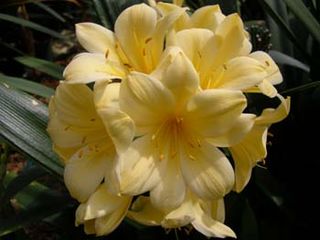
Clivia is a genus of monocot flowering plants native to southern Africa. They are from the family Amaryllidaceae, subfamily Amaryllidoideae. Common names are Natal lily or bush lily.

Faurea is a genus containing 16 species of flowering plants in the protea family which occur in the summer rainfall area of southern Africa, extending to tropical Africa and Madagascar. The name honours South African soldier and botanist William Caldwell Faure (1822-1844) who was killed on active service in India.
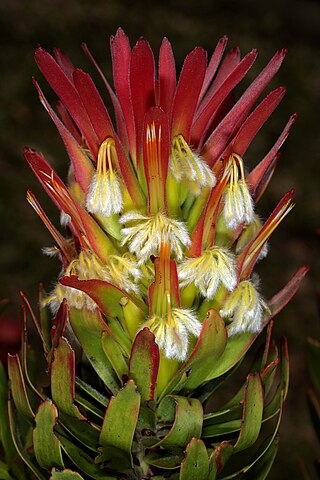
Mimetes, the pagoda, is a genus of evergreen shrubs or small trees 0.5–6 m (1.6–19.7 ft) high, with thirteen species assigned to the family Proteaceae. This genus, as with other proteas, is popular with nectarivorous birds such as the Cape sugarbird and several sunbird species. All species of Mimetes are endemic to the Cape Floristic Region of South Africa.

Serruria, or spiderhead is a genus of flowering plants in the family Proteaceae, endemic to South Africa.
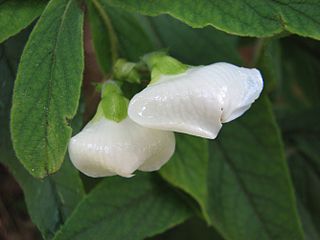
Stilbaceae is a family of flowering plants in the order Lamiales.

Harriet Margaret Louisa BolusnéeKensit was a South African botanist and taxonomist, and the longtime curator of the Bolus Herbarium, from 1903. Bolus also has the legacy of authoring more land plant species than any other female scientist, in total naming 1,494 species.

Vexatorella is a genus containing four species of flowering plant, commonly known as vexators, in the family Proteaceae. The genus is endemic to the Cape Floristic Region of South Africa. The name means “little trouble-maker”, given with reference to the initial difficulties of placing V. latebrosa within the family. All species are shrubs which occur in dry fynbos habitats on the fringes of the Succulent Karoo ecoregion. The inflorescences are similar to those of the related leucospermums but also share features of the leucadendrons, with the floral bracts becoming woody and enlarged following pollination. The flowers are insect-pollinated, with the seeds dispersed by ants (myrmecochory).

Sorocephalus is a genus containing 11 species of flowering plants, commonly known as powderpuffs, in the family Proteaceae. The name means “heaped head”. The genus is endemic to the Cape Floristic Region of South Africa, more particularly the winter rainfall zone of the southwestern Cape. The species are all small shrubs characterised by flower-heads containing clusters of four or more flowers. Most species are threatened.

Spatalla is a genus containing 20 species of flowering plants, commonly known as "spoons", in the family Proteaceae. The genus is endemic to the Cape Floristic Region of South Africa where it is associated with fynbos habitats. The species are all small shrubs. The name is derived from the Greek, meaning “wantonness”, alluding to the plants’ unusually large pollen-presenters. Most species are threatened.

Diastella is a genus containing seven species of flowering plants, commonly known as “silkypuffs”, in the protea family. The name comes from the Greek diastellein “to separate”, with reference to the free perianth lobes – the plants are distinguished from the closely related and similar leucospermums by the possession of four free perianth segments. The genus is endemic to the Cape Floristic Region of South Africa where it has a very limited range and is associated with fynbos habitats. The species are all small shrubs. Most species are threatened.
Campylostachys is a genus of flowering plants in the family Stilbaceae described as a genus in 1832.
Thesmophora is a genus of flowering plants in the family Stilbaceae described as a genus in 1993.

John Patrick Rourke FMLS is a South African botanist, who worked at the Kirstenbosch National Botanical Garden and became curator of the Compton Herbarium. He is a specialist in the flora of the Cape Floristic Region, in particular the family Proteaceae.
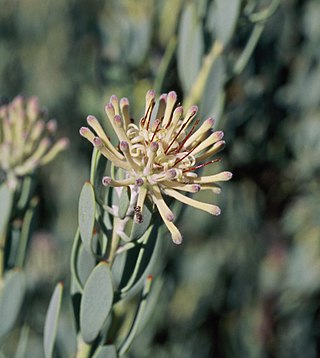
Vexatorella alpina, the Kamiesberg vexator, is an evergreen, upright shrub of up to about 1½ m high, in the family Proteaceae. It has entire, long inverted egg-shaped, bluish grey, leathery leaves of 3–4½ cm (1.2–1.8 in) long and 5–13 mm (0.2–0.5 in) wide on a distinct stalk, and globular flower heads of about 2 cm (0.8 in) across at the tip of the branches, and consisting of pale pink flowers with extended, thick-tipped styles. The plants are flowering from September to November. It is an endemic species that is restricted to the Kamiesberge in South Africa.
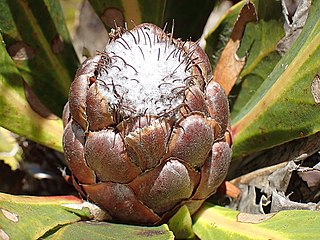
Protea vogtsiae, also known as the Kouga sugarbush, is a small flowering shrub of the genus Protea within the family Proteaceae, which is only found growing in the wild in the southern Cape Region of South Africa.

Penaea is a genus of flowering plants in the family Penaeaceae, found in southern South Africa. They have an unusual type of embryo sac development; after two rounds of mitosis, four nuclei are formed at each pole, leading to a mature embryo sac containing four polar groups each with three cells. When found in other taxa, these embryo sacs are termed Penaea-type.















